Sep 14, 2021
Are you a Pro with a Pontoon Boat?
Pontoon boats are a relaxing way to enjoy boating any season of the year.
It’s Fall, and there are still days when you will wish you could be out on a pontoon boat. It might be a little cooler, but after the hot summer, it will be refreshing.
Pontoon Boats are unique
Pontoon boats have their own style with many amenities available. These boats are different in many ways from a normal powerboat. Handling them is another animal to tackle. Check out this article to get the most use of your pontoon boat.
Docking and Undocking
Pontoon boats leave the dock like any other vessel on the water. Yet, their body shape creates more surface area for the wind to push around. It amounts to a “giant sail.”, the tubes and vertical fences found around the deck act as a sail.
Adding to that difficulty are the boat tubes, which provide your floatation. Large gusts of wind are your mortal enemy. They can knock you off course on the water. The ability to push your pontoon into other boats means you need to know how to handle a pontoon boat. Plus, you must have stellar insurance coverage. SEE
To counter the winds, you have to be aware of them at all times. The pontoon boat’s secret is its exceptional control when used with short bursts of power. Regardless of what type of boat you use, idle the engine and point the motor in the direction you want to go. Then shift into gear. Next, use short bursts of power as you steer the boat. Before you know it, you’ll be out of the dock.
You’ll use the same understanding of the wind and maneuvers when heading back into the marina. Docking any powerboat (pontoons included) requires a little more side-to-side motion. You can learn more about these actions via this link.
Beaching
Beaching or mooring your boat to swim is half the fun of boating, no matter what type of vessel you own. People love beaching their boats to explore islands or soak up the sun. Luckily, both are simple processes and the same for every type of powerboat.
Start by traveling slow when you hit shallow waters, so you don’t damage your motor. Beaching requires you to push the front end of your vessel onto land. Do this carefully to prevent damage to the tubes.
Don’t head onto the beach too far; allow enough room to spin the boat around out into the water using the motor.
For mooring, make sure you have the proper tools to secure your boat via the anchor. Pontoon boats are more buoyant, so use fenders to protect your boat from other vessels.
Turning and Handling
Pontoon boats soar across the water, which makes handling them a ton of fun. Before you lose yourself in the moment, remember that there are no lanes out on the water. Always check your surroundings before making a turn or spinning your boat around.
With that safety tip in mind, you’re ready to tackle the water. Pontoon boats are very stable. You don’t have to worry about flipping or rolling the boat over in normal conditions.
But rough waves and tight turns mean you can’t rule out the possibility. Still, it isn’t much of a concern for the modern pontoon boat.
You do have to worry about causing the propeller to leave the water when making a tight turn. You can either back off of the turn, deaccelerate or trim the engine downwards to remedy the issue. When making sharp turns, equipment and people on your deck are likely to be tossed to one side depending on the speed. Do they have life preservers?
Acceleration
Once you hit open waters, you’re ready to pick up speed. Don’t treat your pontoon boat like a race car, though. Instead, speed up steadily until you reach your desired speed. Keep in mind that the bow will level out, which means you’ll need to trim the engine if you want more speed.
Your engine might rise too far out of the water as you speed up. That’s normal and easy to fix by trimming the motor. Your boat may slow down, and you’ll hear a howling sound near the propeller. Or, the boat will lose a little stabilization when this happens.
Keep in mind that every boat comes with a manufacturer’s recommendation for top speeds or RPM. Most recommend 75% of fully open throttle. It helps to read up on this statistic before pushing your boat to its limits. Use less throttle for more fuel efficiency.
Keep in mind that more crowded waters demand slower speeds. There are rarely legal speed limits on open water, so be mindful of other boaters in the area. Keep an eye out for swimmers as you approach other boats or the shoreline.
Stability Tips in Rough Waters
A pontoon boat handles well, even in rough water, thanks to its dual or triple hull design. Yet, even with the added help, you need to drive a pontoon boat carefully in these conditions.
Experienced boaters recommended that you keep an even load on board. To do this, you must include both objects and passengers. When rough waters arise, make sure your passengers know to even out their weight on deck and sit down. Don’t forget to make them wear life preservers for their safety. The larger your boat, the easier this is to maintain.
Try to avoid heading straight into giant waves. Excessive splashing could damage the electronics in your boat if they take on water. If you must head nose-first into oncoming waves, trim the engine down to help keep the boat’s nose/bow upward. Otherwise, take the waves at a 30 to 40-degree angle.
Finally, sports handling packages are an enormous benefit here. These include better nosecones, power-assisted steering, and higher horsepower to combat choppy waters.
Become a Pro
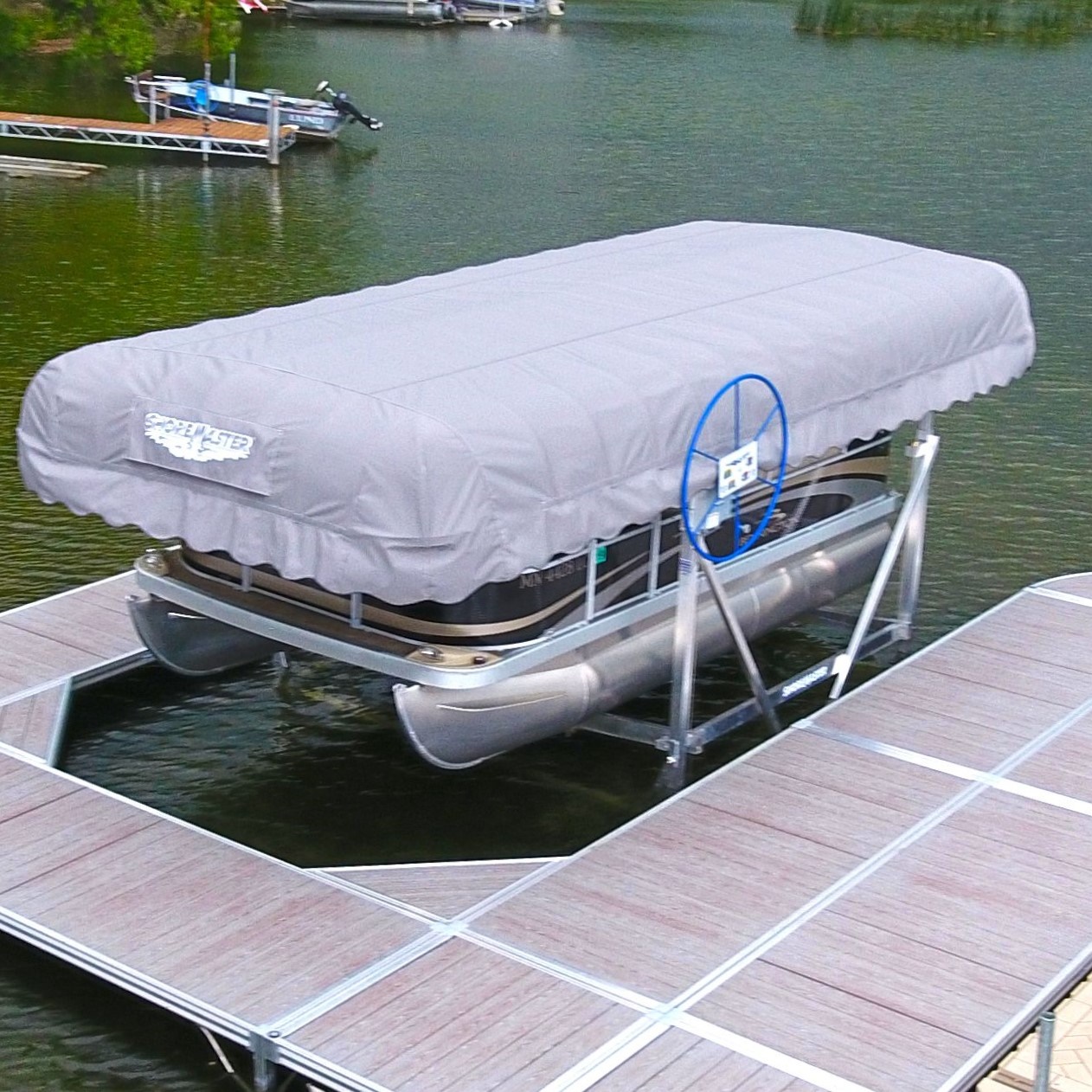
Pontoon Boat Lift
That means don’t head out onto the water when you know a storm is on the way. A pontoon boat is an investment you don’t want to risk for a few more minutes of fun. If inclement weather strikes, head back to the dock and put your boat back on your lift.
Where is Pier & Waterfront Solutions?
Located at 7325 St. Hwy 57, it’s 3 miles south of Sturgeon Bay and 1 mile past the intersection of Cty MM (heading north). Look on the right side, one mile north, at the next corner (Idlewild Road and Hwy 57).
For your protection PWS implemented these preventive measures:
1. Conducting as much business as possible by email, text, or phone.
2. Site visits will continue. When in-person contacts are necessary, we will follow “social distancing” guidelines.
3. Our display yard is always open for you to examine at your leisure. All displays have a numbered, red tag on them. If you want more information or pricing, please reference that number.
Thank you for allowing us to work with you.
YES – PWS is OPEN and waiting for you!
Please call, message, or email PWS with any questions.
Let’s all stay safe!
Nov 3, 2020
Meet the Newest Member of our Sales Team

Eric DeBaker
Pier & Waterfront Solution’s sales and service team extends a welcome to Eric DeBaker.
Born and raised in Southern Door County, Eric currently resides in Appleton. He lives with his wife and 15-year-old son.
A graduate of Southern Door High School, Eric made technical sales for Miller Electric and Metal Man Work Gear Co.
He also worked in the real estate industry, helping homeowners and investors with real estate purchases at Coldwell Banker Real Estate group.
Additionally, Eric assisted trucking companies to comply with DOT and OSHA Requirements at J.J. Keller & Associates.
Oct 27, 2020
Does Shoreline Stabilization Work?
Creating shoreline stabilization sounds pretty easy to do. Just throw some big rocks on the shore. Right!? But when you leave your shoreline, do you really think it will do the job you intended it to do?
In reality, it is labor and equipment intensive and requires special equipment and permits.
What do I have to gain by stabilization of my shoreline?
You have a lot to gain from shoreline stabilization. Waterfront property is always more expensive in comparison to a property with no waterfront. Therefore by installing erosion control (in this case, riprap), you are protecting your investment. If the shoreline is washed away or damaged, your property values diminish along with it.
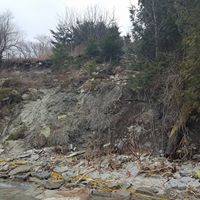
Shoreline Stabilization required
Shoreline erosion can happen from numerous conditions. The typical way is from waves crashing into the shoreline. As this happens, the waves begin to undermine the foundation of the beachfront. When the shoreline is not stable, you’ll lose your lawn, trees, shrubs, and your waterfront. When a bank is unstable, it’s not safe.
There are different ways to “shore” up a beach. The two most common ways to stabilize your shoreline – riprap (limestone or granite) and steel sheet piling.
The riprap method consists of using 8″ – 30″ stones to cover the shoreline’s exposed areas. Adding riprap allows the waves to lose their energy as they pass over and into the rocks.
NOW for the proof!
Pictures are worth a thousand words!
Have you ever watched riprap in action?
Thanks to one of our many customers, we have a short video that demonstrates how riprap works. Press below –
Notice how the waves start to climb the riprap, but they dissipate in the rocks’ openings. Once the water drops below the riprap’s outer surface, it is further dispersed by more rocks under the surface.
In a major storm, some waves go so high that the spray from the waves will break over the top, as shown near the end of the video.
Be sure to call Pier & Waterfront Solutions if you would like information about the design, permitting, or erosion control estimates.
At Pier & Waterfront Solutions, we provide a free site survey to determine the best material and design for your next dock.
Want to learn more about rip-rip?
Follow this link.
Contact Dave today to get started!
Call 920-905-2588 or email Dave@wisconsinpws.com
Where are we located?
Pier & Waterfront Solutions (PWS) specializes in expert rip-rap installation from beginning to end. We are located in the center of Door County at 7325 St Hwy 57 south of Sturgeon Bay at the intersection of Idlewild Road. We look forward to serving all of your waterfront needs.
Jul 14, 2020
Dock Steps with Handrails
Dock Steps from Pier & Waterfront Solutions (PWS) solve many problems for property owners. All-aluminum steps are available in (4) and (6) step configurations. These will never rust, rot, or require maintenance.
Is your ramp or ladder too steep or uncomfortable for your family to use? Is a ladder too hard to climb at the end of your dock? It’s time to look at aluminum steps. A set of dock steps can be an excellent alternative to access your dock.
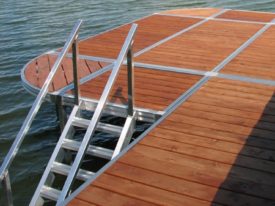
Dock steps
Use them:
- Anywhere along the edge of your dock;
- Use them in place of a ramp if it is too steep to get comfortably to your dock;
- Use them to get from a seawall to the beach or directly to your dock; or
- To access the deck on your house. (no wood to rot or paint)
Is your embankment too high for even a (6) step unit?
These versatile steps join together to form longer units. You are not limited to 4 or 6 steps.
Starting with four steps, you can go to 6, 8, 10, or 12 steps. Use them to go down rough or slippery embankments to make a steady incline. Why risk a fall or injury?
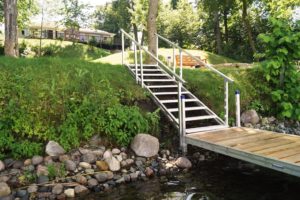
Dock Steps on the embankment
The example above shows a combined (4) and (6) step unit, to form gradual access to the dock.
These versatile steps can be mounted on a seawall for access to the beach also. You don’t have to risk a fall on the slippery, wet embankment to get to your beach or dock. Steps are a natural solution to your landscaping issues.
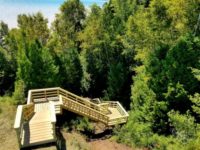
Stairs
Need something even longer?
PWS custom-builds steps in whatever size and shape you need.
Maybe steps are not for you!
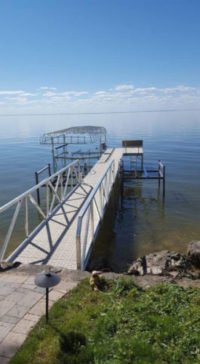
Gangway off a seawall
How about a 16′ up to 24′ gangway?
A gangway is another alternative to consider. Use an all-aluminum walkway from a seawall or embankment to the beach. Don’t let rip-rap or steep embankments hold you back. No need to risk twisting your ankle!
Gangways are available in 16′, 20′ and 24′ lengths.
Steps or gangways can also be used to gain access to a deck at your house or down a steep parking area to the house. Be sure to check out the gangway and step units in our front “pond” display.
Remember, Pier & Waterfront Solutions (PWS) specializes in Waterfront Solutions for docks and lifts.
For more information and what works best for your area, contact Jerry @ (920) 493-4404 TODAY – or – fill out this simple quote request form.
Where is Pier & Waterfront Solutions?
Located at 7325 St. Hwy 57, it’s 3 miles south of Sturgeon Bay, and 1 mile past the intersection of Cty MM (heading north). Look on the right side, one mile north, at the next intersection (Idlewild Road and Hwy 57).
ARE WE OPEN?
During this time of uncertainty, Pier & Waterfront Solutions has stayed “open.” We have implemented measures to ensure the safety of our employees and visitors. At the same time, we are working to maintain the trusted service that you have come to expect.
We are conducting as much business as possible by email, text, or phone. Site visits will continue as usual. When in-person contacts are necessary, we will follow “social distancing” guidelines.
Our display yard is always open for you to examine at your leisure. All displays have a numbered, red tag on them. If you want more information or pricing, please reference that number.
We provide estimates and invoices by email to make the process paperless and faster. With these measures, we hope everyone will stay safe, and we will be back to normal operations soon.
What can YOU do to help us?
Please conduct as much business as possible via emails, messaging, and emails. When you see our crews installing equipment, please practice “social distancing.”
Please call, message, or email us with any questions.
Thank you for allowing us to work with you.
Let’s all stay safe!












